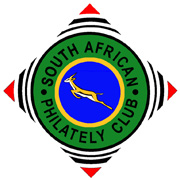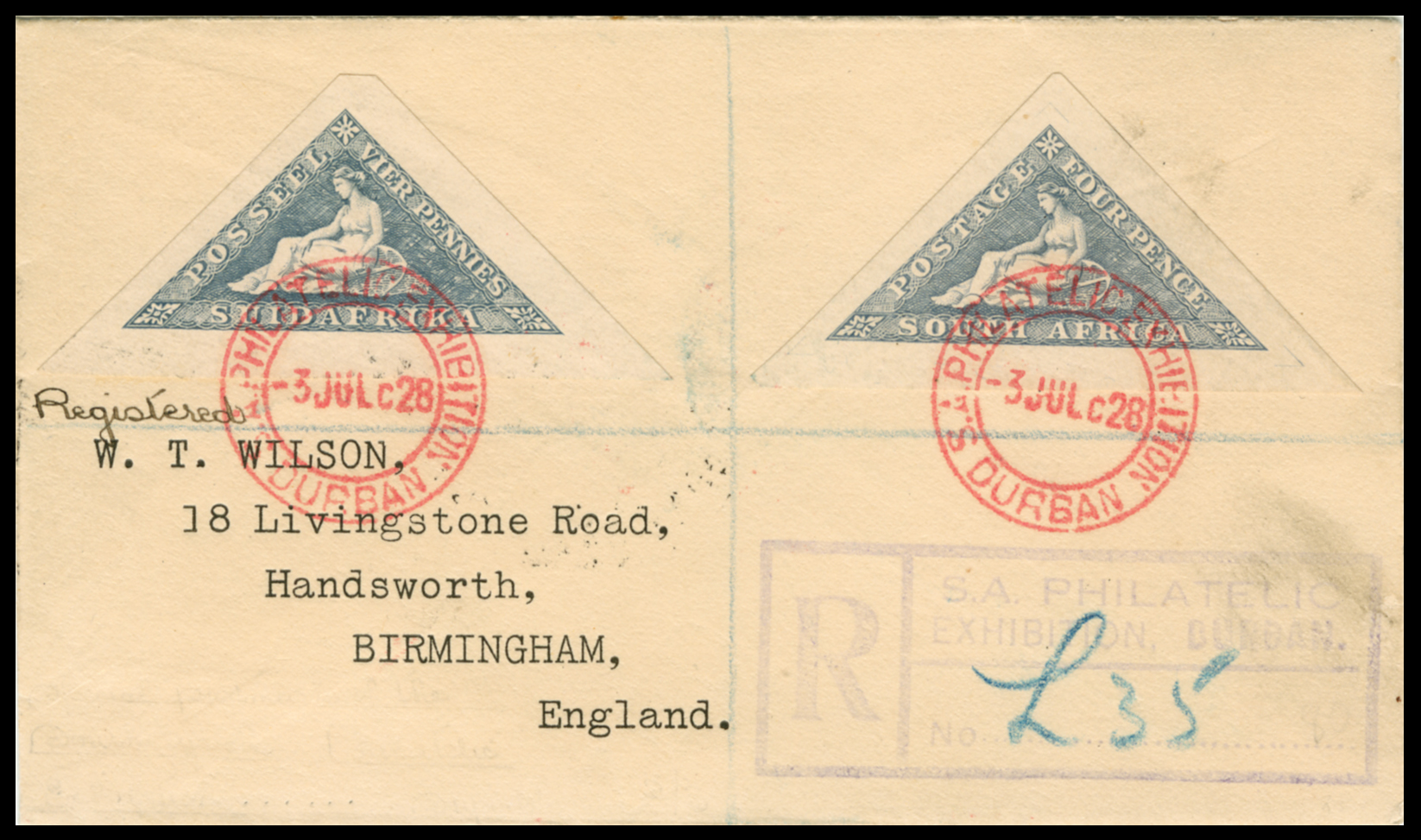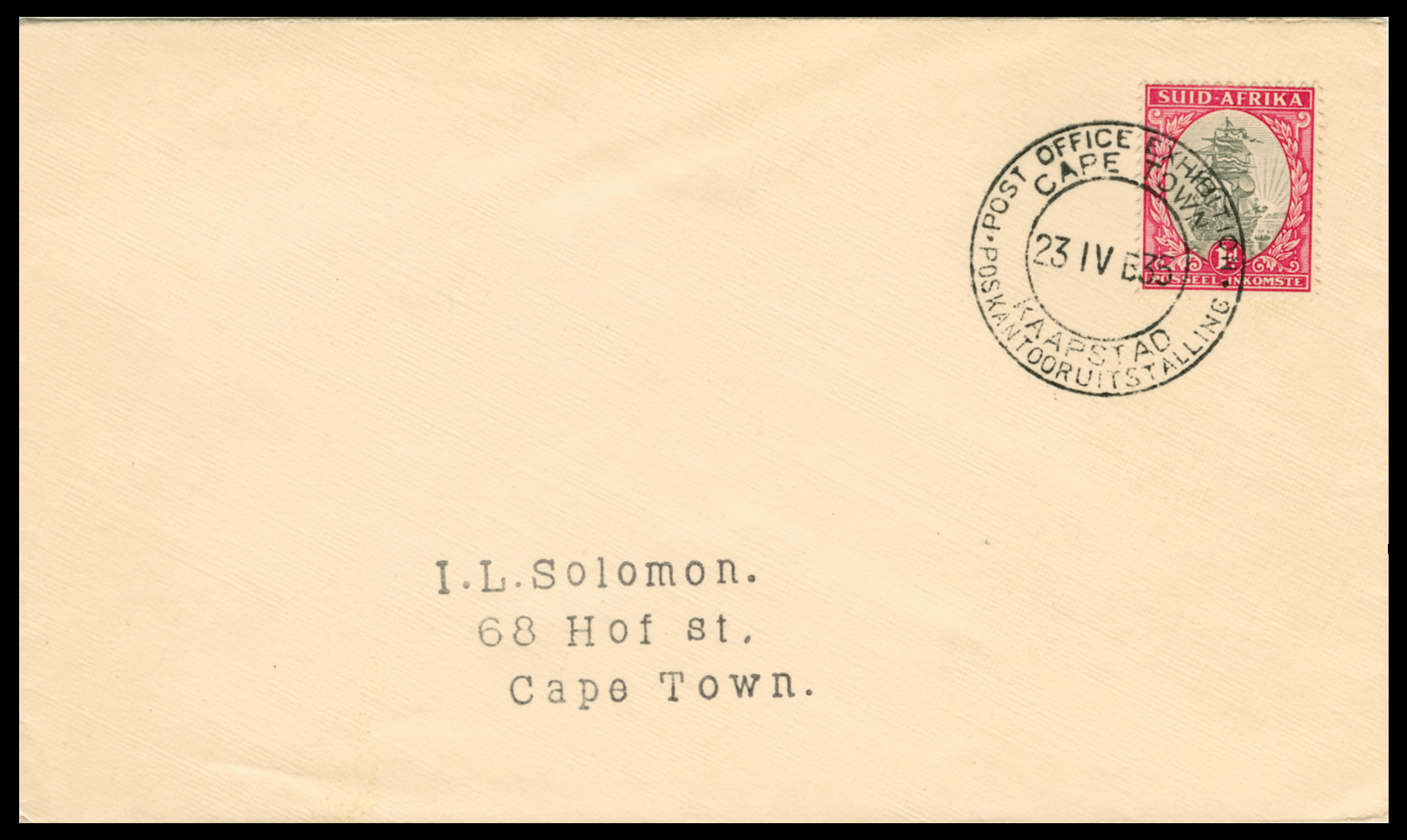PHILATELIC EXHIBITIONS
Quote from Steve on October 24, 2022, 10:53 amI thought that this could be an interesting thread if members were to post examples of their Philatelic and Post Office Exhibition covers.
According to Hasso Reisener's 'The Special & Commemorative Postmarks, Cachets & Covers of South Africa 1892 - 1976', the South African and International Exhibition, Kimberley, was the first in SA to use a special exhibition datestamp and a special printed cover (30 January 1892) and have a special temporary post office at the exhibition (8th September to 8th December 1892). This exhibition used two different datestamps, his No. 1, a large Double Circle and No. 1a, a small Single Circle with 'EXHIBITION' separated by two dots on either side above 'KIMBERLEY'. "This postmark", says Reisener, "can be regarded as the first recorded and earliest known special South African postmark". Reisener's No. 2 is from the Cape Town Exhibition of 26th November 1904 to 28th February 1905.
If you have examples of these and other Philatelic and Post Office Exhibition covers, please share them with us here.
Some two years ago - how time flies - Yannis posted a wonderfully informative PDF file on the Kimberley Exhibition. This includes the only known copy of the exhibition cachet. Click on the PDF file. You can see it here:
I attach two examples of covers in my possession.
SA Philatelic Exhibition, Durban, 1928.
The first is a standard philatelic cover from the SA Philatelic Exhibition, Durban, 2nd - 12th July 1928 to Birmingham, posted on '3 JUL 28'. I hesitate to show this humble cover here having recently seen at the SACS meeting in Letchworth the Lester's magnificent display of covers bearing the 1928 4d Union of South Africa triangle, a visual feast that contained several covers bearing this postmark, Reisner's No. 18, in red and black, possibly even green and blue if memory still serves me.
Post Office Exhibition - Cape Town, 1935.
I do not hesitate to show the second cover bearing Reisener's No. 35 from the Post Office Exhibition - Cape Town. Reisener states that this exhibition ran from the 7th - 18th May 1935, an event that took place in Flethcher and Cartwrights Tea Room which was within a stone's throw of Cape Town GPO and a short and delightful walk from the addressee's home in Hof Street, Gardens. Reisner states that 1091 cards were distributed between 7th - 11th May 1935. So, why is my example on cover, not card, dated '23 IV 35'?
This is two weeks before the Exhbition started! Putzel shows the standard canceller used between 7th - 11th May 1935 which he lists as No. C9. However, he also lists another with a date of 12 IV 35 as C9a. This is 11 days earlier than mine. Putzel says it is "either a date error or PO proof copy". I have a few other items addressed to Mr Solomon which suggest he was able to collect postal curiousities. Perhaps mine and Putzel's C9a are indeed proof copies.
I thought that this could be an interesting thread if members were to post examples of their Philatelic and Post Office Exhibition covers.
According to Hasso Reisener's 'The Special & Commemorative Postmarks, Cachets & Covers of South Africa 1892 - 1976', the South African and International Exhibition, Kimberley, was the first in SA to use a special exhibition datestamp and a special printed cover (30 January 1892) and have a special temporary post office at the exhibition (8th September to 8th December 1892). This exhibition used two different datestamps, his No. 1, a large Double Circle and No. 1a, a small Single Circle with 'EXHIBITION' separated by two dots on either side above 'KIMBERLEY'. "This postmark", says Reisener, "can be regarded as the first recorded and earliest known special South African postmark". Reisener's No. 2 is from the Cape Town Exhibition of 26th November 1904 to 28th February 1905.
If you have examples of these and other Philatelic and Post Office Exhibition covers, please share them with us here.
Some two years ago - how time flies - Yannis posted a wonderfully informative PDF file on the Kimberley Exhibition. This includes the only known copy of the exhibition cachet. Click on the PDF file. You can see it here:
I attach two examples of covers in my possession.
SA Philatelic Exhibition, Durban, 1928.
The first is a standard philatelic cover from the SA Philatelic Exhibition, Durban, 2nd - 12th July 1928 to Birmingham, posted on '3 JUL 28'. I hesitate to show this humble cover here having recently seen at the SACS meeting in Letchworth the Lester's magnificent display of covers bearing the 1928 4d Union of South Africa triangle, a visual feast that contained several covers bearing this postmark, Reisner's No. 18, in red and black, possibly even green and blue if memory still serves me.
Post Office Exhibition - Cape Town, 1935.
I do not hesitate to show the second cover bearing Reisener's No. 35 from the Post Office Exhibition - Cape Town. Reisener states that this exhibition ran from the 7th - 18th May 1935, an event that took place in Flethcher and Cartwrights Tea Room which was within a stone's throw of Cape Town GPO and a short and delightful walk from the addressee's home in Hof Street, Gardens. Reisner states that 1091 cards were distributed between 7th - 11th May 1935. So, why is my example on cover, not card, dated '23 IV 35'?
This is two weeks before the Exhbition started! Putzel shows the standard canceller used between 7th - 11th May 1935 which he lists as No. C9. However, he also lists another with a date of 12 IV 35 as C9a. This is 11 days earlier than mine. Putzel says it is "either a date error or PO proof copy". I have a few other items addressed to Mr Solomon which suggest he was able to collect postal curiousities. Perhaps mine and Putzel's C9a are indeed proof copies.
Uploaded files:Quote from Steve on August 15, 2025, 1:01 pmJIPEX and the Empire Exhibition 1936 - 1937.
As I was in a hurry, I asked Grok, Elon Musk's AI, for a 100 word precis on JIPEX. This is exactly what it supplied.
"The Johannesburg International Philatelic Exhibition (JIPEX), held from November 2-14, 1936, during the Empire Exhibition at Milner Park, celebrated Johannesburg’s Golden Jubilee and the British Empire. Organized by the Johannesburg Philatelic Society, JIPEX featured in Hall 36, showcasing philatelic collections from 18 nations. Specially overprinted ½d Springbok stamps from 1935 booklet panes, marked "JIPEX 1936," were issued, becoming prized collectibles. The exhibition attracted global attention, with philatelic displays complementing the broader Empire Exhibition’s focus on imperial unity and South African progress. Visitors accessed JIPEX via a dedicated corridor, enhancing its prominence within the larger event." As Grok's precis is useful, I use it here. Note the omission of the 1d Red Ship overprint.
The 'thing' about the Empire Exhibition for philatelists is that it was the provider of two new issues of South African stamps, one a set of two overprinted definitives dedicated and limited to JIPEX, the philatelic do, and the other a new defintive for everyday public postal use. On cover below are the '½d Springbok stamps' as described by Grok, as well as the 1d Ship stamp which Grok omitted from its precis.
Our compliments to Roy Ross for sharing these items with as, as well as the one below. Thanks, Roy! Anyone who wants a full understanding of JIPEX stamps and covers, as well as the Empire Exhibtion, should CLICK HERE to see Roy's display.
Not all First Day Covers from JIPEX bore the over-printed definitives. Here is an example submitted by Roy that does not.
.
The cover below is not a JIPEX item like the "specially overprinted" stamps from 1935 booklet panes, marked 'JIPEX 1936'. This is an Empire Exhibition promotional cover cancelled during JIPEX. The 1½d Gold Mine was the second issue of new stamp(s) during this philatelic event. Nothing on this cover refers to JIPEX other than that it was cancelled during the time of JIPEX, November 2-14, 1936.
1936. First Day Cover. EMPIRE EXHIBITION JOHANNESBURG '12 XI 36' to BULAWAYO, S. Rhodesia.
Small Empire Exhibition label tied to cover by 'THE GOLDEN CITY 1886 JUBILEE 1936" machine cancel.
The stamp is First Day of Issue of the 1½d Gold Mine, the first stamp to use gold ink.
Unlike the FDCs bearing pverprints which are printed 'FIRST DAY COVER' in red, this is printed in green.As JIPEX began on the 2nd November 1936, this is not a FIRST DAY COVER from its opening day. If it was it would bear the "specially overprinted ½d Springbok stamps from 1935 booklet panes, marked "JIPEX 1936". The stamp seen on the cover above is the First Day of Issue of the 1½d Gold Mine. Thus JIPEX offered philatelists two new stamp issues in 10 days. Is there another South African Philatelic Exhibition that saw two new stamps from different sets released during the time it was open? Please advise.
The Empire Exhibition ran from 15th September 1936 to 1st February 1937, ie. JIPEX was only a small part of it. The special bilingual machine cancel shown above, 'THE GOLDEN CITY 1886 JUBILEE 1936', (Afr. DIE GOUDSTAD JUBILEUM), was used for many months before the EMPIRE EXHIBITION opened in order to publicise it. "This machine canceller was used up to 16th January 1937". (Hasso Reisener. Special and Commemorative Postmarks of SA.).
1937. Cover. EMPIRE EXHIBITION JOHANNESBURG '18 I 37' to MILNER PARK, Johannesburg.
Cancelled with the bilingual double circle Empire Exhibition / Rykstentoonstelling datestamp. Type 1.
Uncommon round Empire Exhibition label affixed to cover.Again, our thanks to Roy Ross for the info on JIPEX and Empire Exhibition postmarks below.
JIPEX and the Empire Exhibition 1936 - 1937.
As I was in a hurry, I asked Grok, Elon Musk's AI, for a 100 word precis on JIPEX. This is exactly what it supplied.
"The Johannesburg International Philatelic Exhibition (JIPEX), held from November 2-14, 1936, during the Empire Exhibition at Milner Park, celebrated Johannesburg’s Golden Jubilee and the British Empire. Organized by the Johannesburg Philatelic Society, JIPEX featured in Hall 36, showcasing philatelic collections from 18 nations. Specially overprinted ½d Springbok stamps from 1935 booklet panes, marked "JIPEX 1936," were issued, becoming prized collectibles. The exhibition attracted global attention, with philatelic displays complementing the broader Empire Exhibition’s focus on imperial unity and South African progress. Visitors accessed JIPEX via a dedicated corridor, enhancing its prominence within the larger event." As Grok's precis is useful, I use it here. Note the omission of the 1d Red Ship overprint.
The 'thing' about the Empire Exhibition for philatelists is that it was the provider of two new issues of South African stamps, one a set of two overprinted definitives dedicated and limited to JIPEX, the philatelic do, and the other a new defintive for everyday public postal use. On cover below are the '½d Springbok stamps' as described by Grok, as well as the 1d Ship stamp which Grok omitted from its precis.

Our compliments to Roy Ross for sharing these items with as, as well as the one below. Thanks, Roy! Anyone who wants a full understanding of JIPEX stamps and covers, as well as the Empire Exhibtion, should CLICK HERE to see Roy's display.
Not all First Day Covers from JIPEX bore the over-printed definitives. Here is an example submitted by Roy that does not.
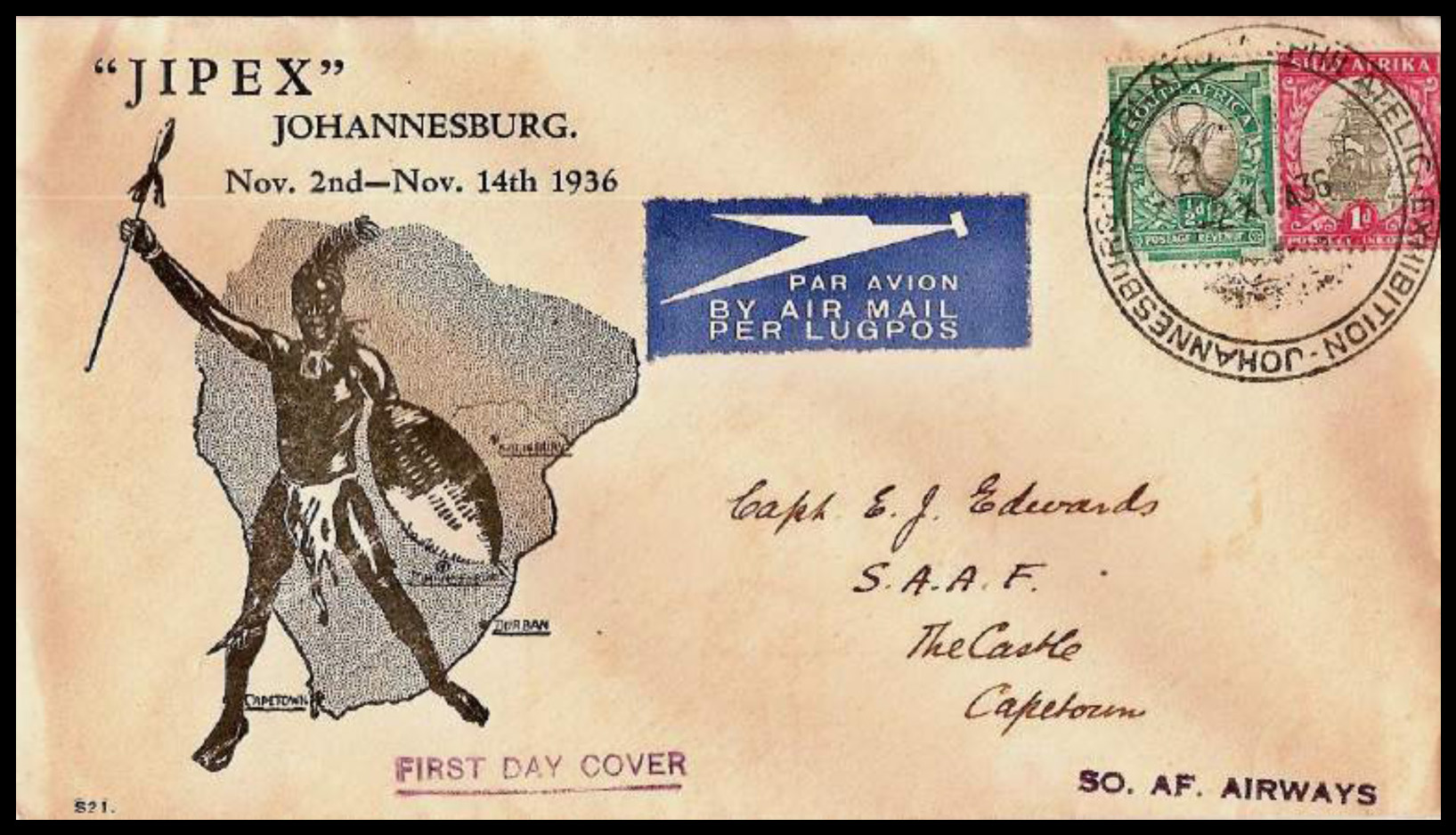 .
.
The cover below is not a JIPEX item like the "specially overprinted" stamps from 1935 booklet panes, marked 'JIPEX 1936'. This is an Empire Exhibition promotional cover cancelled during JIPEX. The 1½d Gold Mine was the second issue of new stamp(s) during this philatelic event. Nothing on this cover refers to JIPEX other than that it was cancelled during the time of JIPEX, November 2-14, 1936.

1936. First Day Cover. EMPIRE EXHIBITION JOHANNESBURG '12 XI 36' to BULAWAYO, S. Rhodesia.
Small Empire Exhibition label tied to cover by 'THE GOLDEN CITY 1886 JUBILEE 1936" machine cancel.
The stamp is First Day of Issue of the 1½d Gold Mine, the first stamp to use gold ink.
Unlike the FDCs bearing pverprints which are printed 'FIRST DAY COVER' in red, this is printed in green.
As JIPEX began on the 2nd November 1936, this is not a FIRST DAY COVER from its opening day. If it was it would bear the "specially overprinted ½d Springbok stamps from 1935 booklet panes, marked "JIPEX 1936". The stamp seen on the cover above is the First Day of Issue of the 1½d Gold Mine. Thus JIPEX offered philatelists two new stamp issues in 10 days. Is there another South African Philatelic Exhibition that saw two new stamps from different sets released during the time it was open? Please advise.
The Empire Exhibition ran from 15th September 1936 to 1st February 1937, ie. JIPEX was only a small part of it. The special bilingual machine cancel shown above, 'THE GOLDEN CITY 1886 JUBILEE 1936', (Afr. DIE GOUDSTAD JUBILEUM), was used for many months before the EMPIRE EXHIBITION opened in order to publicise it. "This machine canceller was used up to 16th January 1937". (Hasso Reisener. Special and Commemorative Postmarks of SA.).
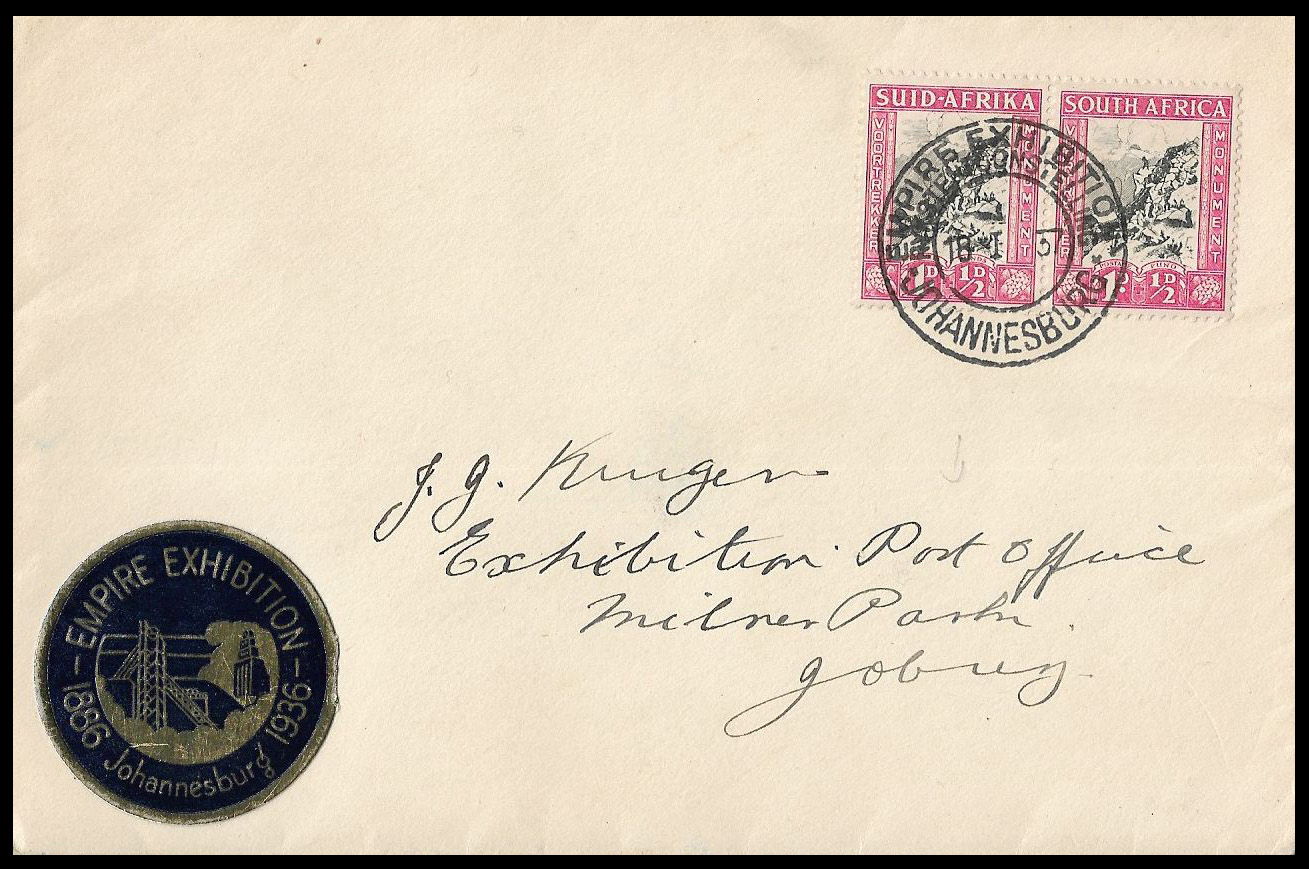
1937. Cover. EMPIRE EXHIBITION JOHANNESBURG '18 I 37' to MILNER PARK, Johannesburg.
Cancelled with the bilingual double circle Empire Exhibition / Rykstentoonstelling datestamp. Type 1.
Uncommon round Empire Exhibition label affixed to cover.
Again, our thanks to Roy Ross for the info on JIPEX and Empire Exhibition postmarks below.
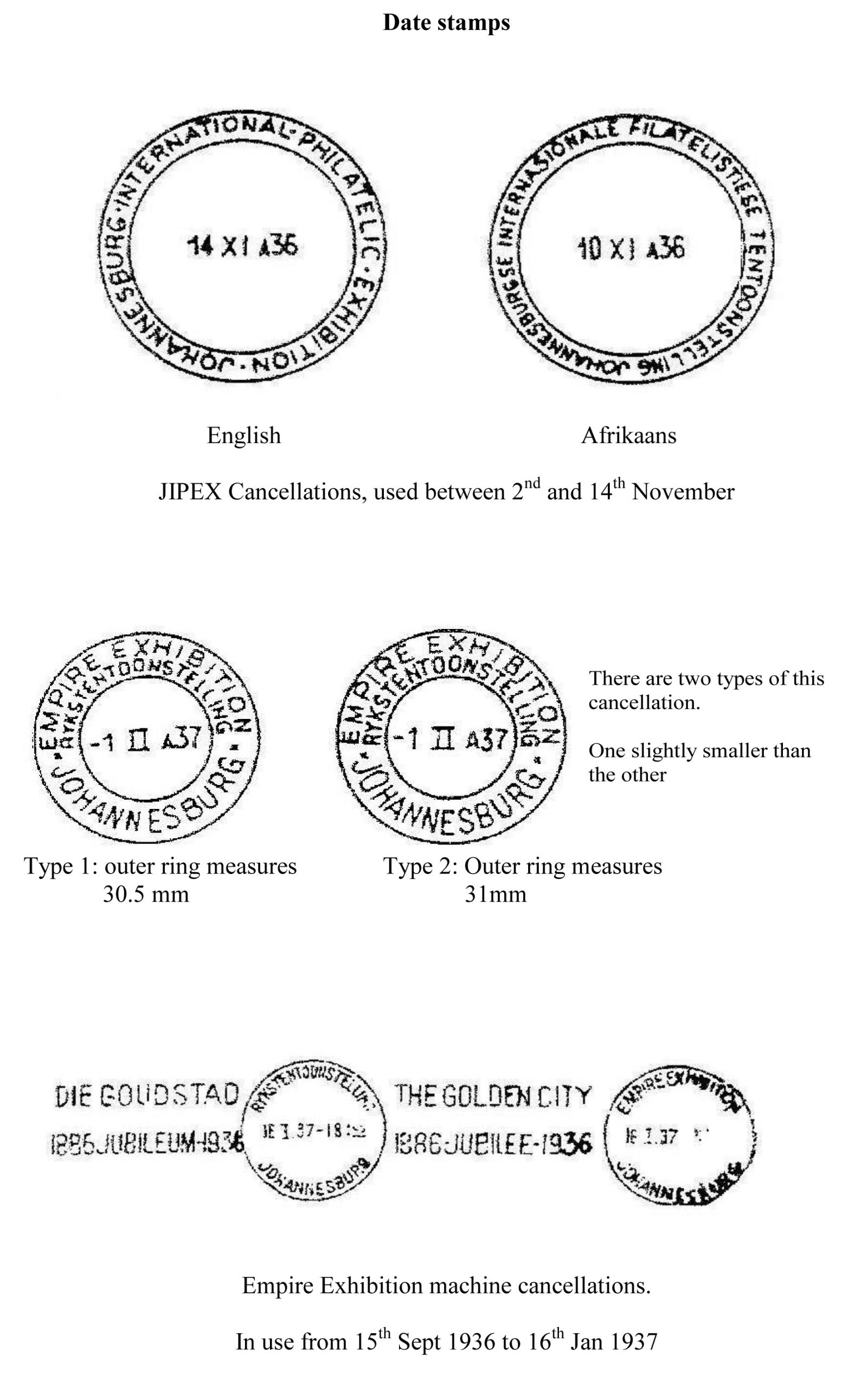
Quote from Steve on August 16, 2025, 12:57 pmNational Philatelic Exhibition, Pretoria, 1948.
I have always liked this cover. I have no strong reason to do so other than my own sense of aesthetics.
This First Day Cover is unaddressed, ie. it has never travelled through the postal system. The temptation is to address it. It is long and only capable of being mounted horizontally on an A3 sheet. That probably explains why I have never displayed it. Nevertheless, I like it. Its many shades of purple are pleasing. The stylised jacaranda tree, the mini-sheet showing four defaced ZAR 3d stamps, the fine strike of the postmark and the block of four Union Building 2ds from 1945 make it slightly better than the sum of the parts.
1948. First Day Cover. '18 X 48'. Unaddressed and unposted.
Pretoria Philatelic Society Golden Jubilee Exhibition 1898 - 1948 minisheet.
Block of four 1945 2d Union stamps cancelled with bilingual 'National Philatelic Exhibition datestamp.According to Reisener, in 1948 "the Pretoria Philatelc Society (PPS) staged a national exhibition during Jacaranda Week". (Hence the choice of colours.) He shows two different size covers from this exhibition, the larger one being that shown above. He says that "Special labels in the form of minisheets were prepared. These show four ZAR Drie Pence mauve stamps printed from the original defaced plates." Curiously, he says "many souvenir covers show this label affixed to the right-hand side .... About 2,500 cover were issued".
This FDC bears 8d worth of stamps, more than enough for local registration. It was probably never intended to be posted but remain as a tribute piece to the minisheet and the block of four Union 2d stamps. I like it 'as is'. I won't address it!
I like to have historical context in my philately. So, ..... the Nationalist Government of D. F. Malan came to power in 1948, the year of this cover. As promised the Nats introduced more segregation through a new policy called 'Apartheid'. As a result South Africa went down a long hard road, one which has not yet led South Africa's people to the promised land. When the Nats came to power philately was strong and popular, but today, post-Democracy, our hobby is in terminal decline. I am not blaming the policies of the Nats or the ANC for what's happened to our hobby but between these two opposites the world experienced great technological change. Unsurprisingly this led young people to fall out of love with stamp collecting, a hobby that celebrates the past more than the present.
National Philatelic Exhibition, Pretoria, 1948.
I have always liked this cover. I have no strong reason to do so other than my own sense of aesthetics.
This First Day Cover is unaddressed, ie. it has never travelled through the postal system. The temptation is to address it. It is long and only capable of being mounted horizontally on an A3 sheet. That probably explains why I have never displayed it. Nevertheless, I like it. Its many shades of purple are pleasing. The stylised jacaranda tree, the mini-sheet showing four defaced ZAR 3d stamps, the fine strike of the postmark and the block of four Union Building 2ds from 1945 make it slightly better than the sum of the parts.
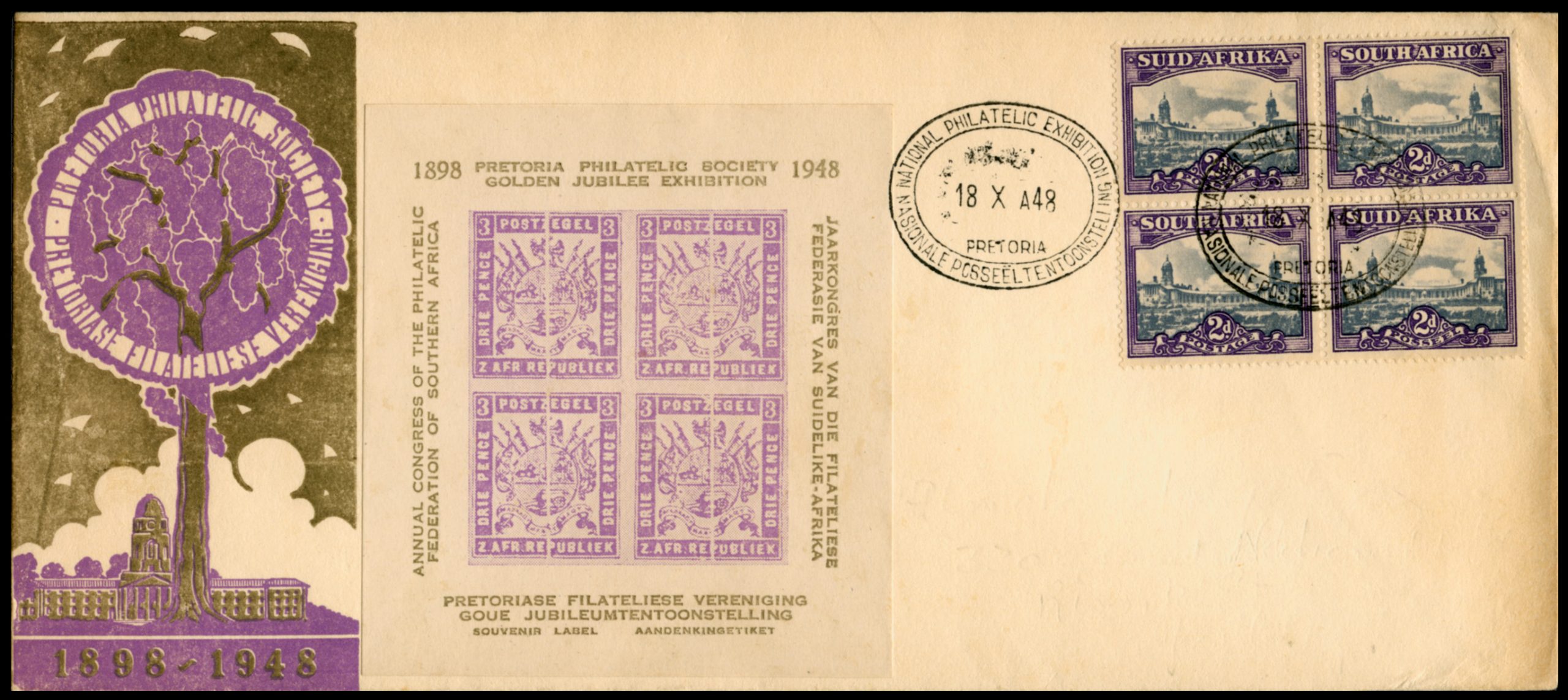
1948. First Day Cover. '18 X 48'. Unaddressed and unposted.
Pretoria Philatelic Society Golden Jubilee Exhibition 1898 - 1948 minisheet.
Block of four 1945 2d Union stamps cancelled with bilingual 'National Philatelic Exhibition datestamp.
According to Reisener, in 1948 "the Pretoria Philatelc Society (PPS) staged a national exhibition during Jacaranda Week". (Hence the choice of colours.) He shows two different size covers from this exhibition, the larger one being that shown above. He says that "Special labels in the form of minisheets were prepared. These show four ZAR Drie Pence mauve stamps printed from the original defaced plates." Curiously, he says "many souvenir covers show this label affixed to the right-hand side .... About 2,500 cover were issued".
This FDC bears 8d worth of stamps, more than enough for local registration. It was probably never intended to be posted but remain as a tribute piece to the minisheet and the block of four Union 2d stamps. I like it 'as is'. I won't address it!
I like to have historical context in my philately. So, ..... the Nationalist Government of D. F. Malan came to power in 1948, the year of this cover. As promised the Nats introduced more segregation through a new policy called 'Apartheid'. As a result South Africa went down a long hard road, one which has not yet led South Africa's people to the promised land. When the Nats came to power philately was strong and popular, but today, post-Democracy, our hobby is in terminal decline. I am not blaming the policies of the Nats or the ANC for what's happened to our hobby but between these two opposites the world experienced great technological change. Unsurprisingly this led young people to fall out of love with stamp collecting, a hobby that celebrates the past more than the present.
